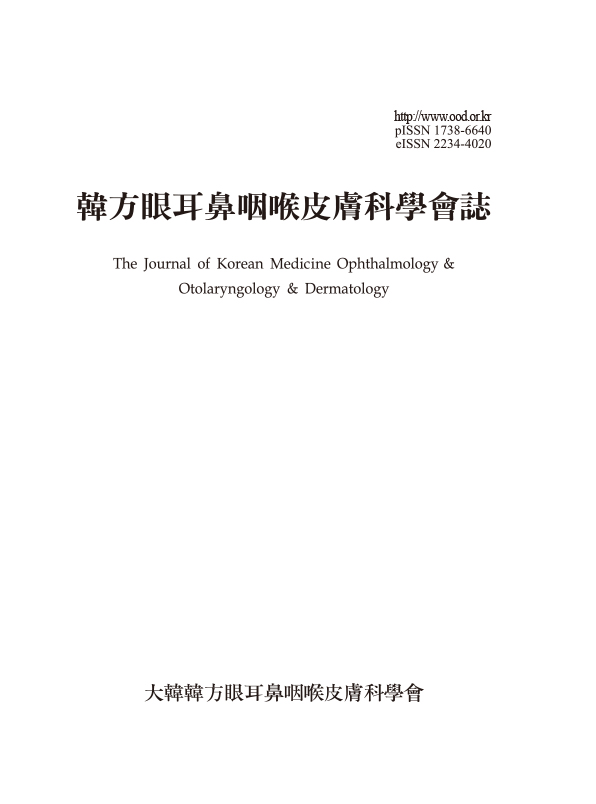Editor & Reviewer Guidelines
1. Editorial board committee comprises about 5 Editorial board members(below members). The Chief of The Society of Korean Medical Ophthalmology & Otolaryngology & Dermatology requests member whose position is above assistant professor among all faculty in each university. And the Editor-in-Chief is elected by the editorial board members. The terms of members are each 2 years and can to serve consecutive terms.
2. Editorial board committee hold regularly on publication schedule. Editorial board committee manage all tasks of edition such as direction of edition, system, the number of publication paper, publication order, reviewer appointment, revision of contribution rules and publication fee, etc.
3. Editorial board committee can have some manuscript editors to get more efficiency of edition.
4. The submitted draft should be reviewed by 3 reviewers and decided whether to be published or not. Editorial board committee can reject the draft which did not comply instructions to authors without any review process.
5. Editorial board committee recommend the reviewers and editor-in-chief commit the reviewers. The names of reviewers are not disclosed. Reviewers are limited to leading researchers in this field with a track record of published papers among full-time teachers in each university, senior researchers of laboratory and doctors. No one can assume the roles of Editorial Board member and reviewer at the same time.
6. Reviewers classify the paper as "accepted in present form", "accepted after revisions" and "rejected at this stage".
7. When the paper is evaluated as "accepted after revisions", the reviewers should indicate corrections specifically. After the author correct inadequate indication, the reviewers or the Editorial board members confirm whether the auther are acceptable in revised form.
8. When the paper is "rejected at this stage", the reviewers should cite specific reasons as to how the decision was reached.
9. Draft can be published when the results of review are 2 or more "accepted in present form".
10. Review is conducted under the subsection "paper system" and " paper basic requirement". Reviewers should review papers making reference to below Editor's & Reviewer's Guide. When the paper doesn't accord with criteria, reviewers can make a decision "rejected at this stage" and should specify where should be made corrections and give a general review. If opinions of members are asked in regard to paper review, reviewers should post review results on the website of the Journal of The Society of Korean Medical Ophthalmology & Otolaryngology & Dermatology.
11. The reviewer should complete reviewing about draft and reply with comments within 15 days.
12. When reviewers do not give a review of the assigned paper within 15 days, they could be dismissed and have to return draft to Editorial board committee.
13. Fixed examination fee is given to reviewers.
14. Editorial board committee should notice the results of review to contributors.
15. The man that use English as first language can be appointed for English an advisory editor.
Criteria for review
1. Paper system
Research process, results and conclusion should be firmly structured in accordance with certain form.
1-1. Research subject
① High levels of understanding for essence of research assignment
② A certain framework set for carrying out research
③ A concise and sufficient statement of research objectives
④ A clear scope of research
1-2. Data collection and methods
① Appropriate data and information collection and organized use of trial outcomes
② Academic approaches to subject based on a certain theory
③ A detailed description of how extraordinary methods or apparatus are used in trials. A clear statement of the definitions of terms and trial data used in the paper
④ A clear statement of any factors able to effect trial outcomes likewise trial condition, research subjects, etc.
1-3. Date analysis and discussion
① A right demonstration of creativity and logicality in research with a proper analysis of collected data by using good methods and discussion of the objective of the research.
② An objective analysis of collected data on a variety of angles and propriety of understanding on review.
1-4. References Consideration
References Citations for how the similar questions were approached and addressed in other studies.
1-5. Conclusion
① A review of how the research conclusion was reached based on collected data and analysis results
② A concise and comprehensive summary taking into account the whole picture
2. Paper basic requirement
2-1. Validity
① A use of organized and scientific methods and flawless procedures.
② A review of how the precise conclusion was gained from the research results.
2-2. Originality
Originality is required for the development of academic research.
2-3. Objectivity
Facts and evidence build a good paper.
2-4. Fairness
The disregard other theories because prejudices and misguided stereotypes is discouraged. Even if they are different, they should be treated equally. All information or theories should be evaluated fairly.
2-5. Elaborateness
Data collection and trial procedures should be prepared meticulously.
2-6. Preciseness
Data should be presented with clear information (statistics, citations, names, titles of books and papers).
2-7. Ethics
Research results should be stated as they are. Other arguments or theories belonging to the other parties should not be treated as your own.
2-8. Validity
If needed, anyone should be able to reproduce what was done in the trials and the papers. Evidence to support arguments, sources of information, research procedures and methods, approaches to research, evaluation standards, etc. should be clearly stated.
2-9. Terms
Terms and sentences that are concise and simple are required in a paper.







